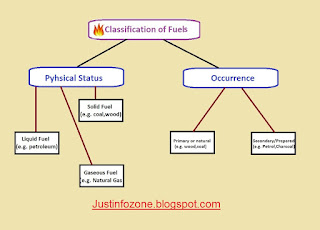A fuel, may be defined as a substance (containing mostly carbon and hydrogen) which on the burning with oxygen in the atmospheric air, produces a large amount of heat. The amount of heat produced is known as calorific value of fuel. So we can called them hydrocarbon fuels.
The fuels may be classified into the following there forms.(Each of these fuels may be subdivided into two types "a" Natural fuel "b" Prepared fuels.
1:Solid fuels
The prepared solid fuels are wood charcoal,coke,briqueted coal and pulversised coal.Natural solid fuels are as below.- Wood
It consists of mainly carbon and hydrogen. The wood is converted when it is heated or burnt. The average calorific value of wood is 19700 KJ/kg.
- Peat
It is the first stage in the formation of coal.Its average calorific value is 23000 KJ/kg
- Lignite or brown coal.
It the next stage of the peat in the formation of the coal.Its average calorific value is 25000 KJ/kg.
- Bituminous coal
It represents the next stage of lignite in the formation of coal.It contains very little moisture upto 4 to 6 % and 75 to 90% of carbon.Its average calorific value is 33500 KJ/kg
- Anthracite Coal
In formation of coal,it is the final stage of the peat.Which contains more than 90% of carbon with a very little amount of volatile matter.It is very suitable for steam raising and general power purposes.Its average calorific value is 36000 KJ/kg.
- Wood charcoal.
It is created when wood is heated with a limited supply of air to a temperature not less than 280 degree centigrade.
- Coke
It is prepared when coal is heated continously for 42 to 48 hours in the absence of a
ir in a closed vessel.This process is also known as carbonisation of coal.Coke is dull black in color and smokeless. It contains 90% of carbon and high calorfic value.
- Briquetted Coal.
It is the form of the finely ground coal by moulding under pressure which or without a binding material.The briquetted coal has the advantage of having no loss of fuel through grate openings and thus it increases the heating value of the fuel.
- Pulverised Coal.
The low grade coal with a high amount of ash, is powder shape coal. This is firsly dried and then crushed into a fine powder by pulverising machines. This coal is widely used in the cement industry and metallurgical processes.
2: Liquid Fuels
Almost all the commerical liquid fuels are prepared from the natural petroleum (crude oil). The liquid fuels contains hydrocarbons. The natural petroleum may be separated into petrol or gasoline,paraffin oil or kerosene oil,fuel oils and lubricating oils by boiling the crude oil at temperatures. The solidproducts like vaseline and paraffin wax are get from the desidue.
The following are some important liquid fuels.
- Petrol or gasoline
It is the lightest and most voltile liquid fuel, used in the petrol engines. It is recovered at the temperature from 65 to 220 degree centigrade
- Kerosene or Paraffin Oil
It is heavier and less voltile than petrol, and is used as heating and lighting fuel. It is distilled at the temperature from 220 to 345 C.
- Heavy Fuel Oils
The liquid fuels distilled after petrol and kerocene oil are named as heavy fuel oils. These oil used in diesel engines and in oil-fired boilers. These are extracted at the temperature of 345 to 470 C.
3:Gaseous Fuels
The natural gas is, usually found near the petroleum fields from the underground surface of the earth. This fuel consists of methane (CH4) with small quantity of other gases like as ethane (C2H6), Carbon Dioxide (CO2) and carbon monoxide (CO).These are the prepared gases used as fuels are following.- Coal Gas
It is also known as town gas. It is obtained by the corbonisation of coal and mainly consists of hydrogen,carbon monoxide and various hydrocarbons.It is used in domestic purposes and for industries it is used in furnaces.
- Producer Gas
It is produced by combustion of different coals like coke,anthracite coal and charcoal. Its manufacturing cost is low.
- Water Gas
It is compound of hydrogen and carbon monoxide and made by passing steam over incandescent coke. Due to its blue flame it is also called blue water gas.
- Mond Gas
It is manufactured by passing air and a large amount of steam over waste coal at about 650 C. It is used in power generation sector and also suitable for gas engines.
- Blast Furnace gas.
It is by-product after manufacturing the pig iron from the blast furnace. It is used in power generation, gas engines and preheating of blast furnace.
- Coke Oven gas.
It is by-product from the coke oven, and is obtained by the carbonisation of bituminous coal. It is used for industrial heating and power generation.


Post a Comment